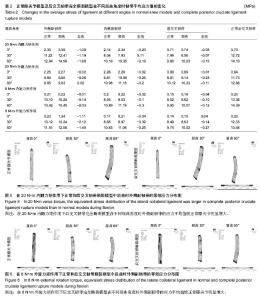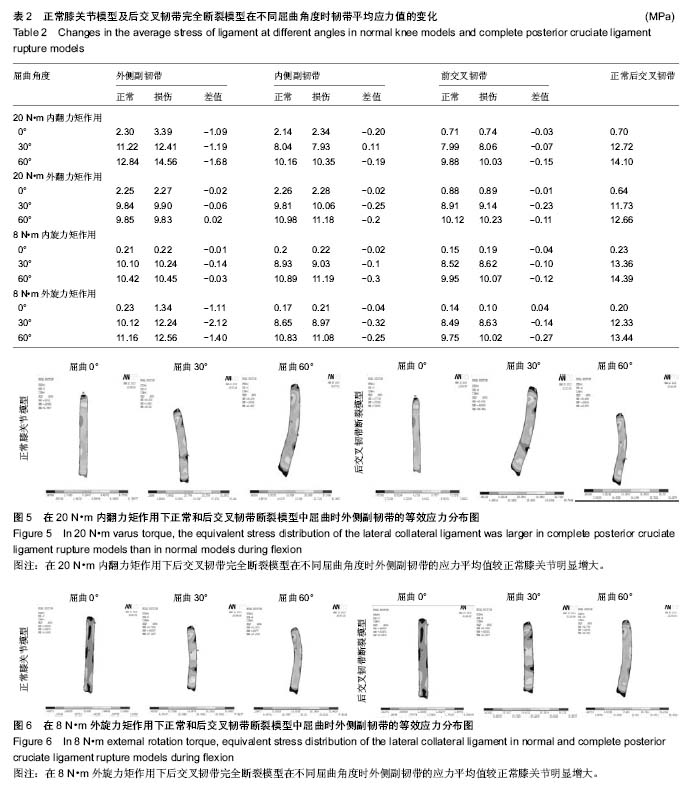| [1] Brekelmans WA, Poort HW, Slooff TJ. A new method to analyse the mechanical behaviour of skeletal parts. Acta Orthop Scand. 1972;43(5):301-317.[2] Rybicki EF, Simonen FA, Weis EB Jr. On the mathematical analysis of stress in the human femur. J Biomech. 1972; 5(2):203-215.[3] Zelle J, Van der Zanden AC, De Waal Malefijt M, et al. Biomechanical analysis of posterior cruciate ligament retaining high-flexion total knee arthroplasty. Clin Biomech (Bristol, Avon). 2009;24(10):842-849. [4] Beillas P, Lee SW, Tashman S, et al. Sensitivity of the tibio-femoral response to finite element modeling parameters. Comput Methods Biomech Biomed Engin. 2007;10(3): 209-221.[5] Mesfar W, Shirazi-Adl A. Computational biomechanics of knee joint in open kinetic chain extension exercises. Comput Methods Biomech Biomed Engin. 2008;11(1):55-61. [6] Chantarapanich N, Nanakorn P, Chernchujit B, et al. A finite element study of stress distributions in normal and osteoarthritic knee joints. J Med Assoc Thai. 2009;92 Suppl 6:S97-103.[7] Guess TM, Thiagarajan G, Kia M, et al. A subject specific multibody model of the knee with menisci. Med Eng Phys. 2010;32(5):505-515. [8] Gíslason MK, Stansfield B, Nash DH. Finite element model creation and stability considerations of complex biological articulation: The human wrist joint. Med Eng Phys. 2010; 32(5):523-531. [9] Frehill B, Crocombe A, Cirovic S, et al. Initial stability of type-2 tibial defect treatments. Proc Inst Mech Eng H. 2010;224(1): 77-85.[10] 刘安庆,张银光,王春生,等.人股骨生物力学特性的三维有限元分析[J].西安医科大学学报,2001,22(3):242-244. [11] 邹磊,詹朝双,史本龙,等.国人正常膝关节几何学参数测量及临床意义[J].解剖与临床,2010,15(4):243-246.[12] Ramaniraka NA, Saunier P, Siegrist O, et al. Biomechanical evaluation of intra-articular and extra-articular procedures in anterior cruciate ligament reconstruction: a finite element analysis. Clin Biomech (Bristol, Avon). 2007;22(3):336-343. [13] LeRoux MA, Setton LA. Experimental and biphasic FEM determinations of the material properties and hydraulic permeability of the meniscus in tension. J Biomech Eng. 2002;124(3):315-321.[14] Li G, Lopez O, Rubash H. Variability of a three-dimensional finite element model constructed using magnetic resonance images of a knee for joint contact stress analysis. J Biomech Eng. 2001;123(4):341-346.[15] Ramaniraka NA, Terrier A, Theumann N, et al. Effects of the posterior cruciate ligament reconstruction on the biomechanics of the knee joint: a finite element analysis. Clin Biomech (Bristol, Avon). 2005;20(4):434-442. [16] Peña E, Calvo B, Martinez MA, et al. Influence of the tunnel angle in ACL reconstructions on the biomechanics of the knee joint. Clin Biomech (Bristol, Avon). 2006;21(5):508-516. [17] Moglo KE, Shirazi-Adl A. Biomechanics of passive knee joint in drawer: load transmission in intact and ACL-deficient joints. Knee. 2003;10(3):265-276.[18] Peña E, Calvo B, Martínez MA, et al. A three-dimensional finite element analysis of the combined behavior of ligaments and menisci in the healthy human knee joint. J Biomech. 2006; 39(9):1686-1701. [19] LaPrade RF, Muench C, Wentorf F, et al. The effect of injury to the posterolateral structures of the knee on force in a posterior cruciate ligament graft: a biomechanical study. Am J Sports Med. 2002;30(2):233-238.[20] Song Y, Debski RE, Musahl V, et al. A three-dimensional finite element model of the human anterior cruciate ligament: a computational analysis with experimental validation. J Biomech. 2004;37(3):383-390. |

